The almost forgotten technique in the UK of grazing cereals is something being widely practiced across Australia in areas with widely varying rainfall levels. The Australian Grain Research and Development Council have produced a report titled Grain and Graze which sets out to evaluate the advantages and disadvantages of grazing a range of cash crops. We began serialising this report over forthcoming issues, exploring what is currently an untapped resource.
Originally Published by Grain and Graze in Australia in 2016 and continuing on from Issue 6 of Direct Driller Magazine
Stocking rate (intensity and duration of grazing)
The three considerations of when grazing starts, the amount of crop to leave behind and when to stop grazing enables a calculation of the total number of grazing days available. Once this is known, the grazing intensity or stocking rate can be calculated if animal consumption is included. Where only a small grazing ‘window’ exists before GS 30 is reached, very high stocking rates are appropriate. This ensures even grazing of the crop and avoids the ‘lawn and rough’ effect that can occur when stock concentrate grazing on a small area. If the period of grazing can be increased through early sowing or very favourable growing conditions, then the approach to grazing can involve a lower stocking rate for a longer period of time. In this case crop growth should also be taken into account.
The effect of different stocking rates on crop dry matter is illustrated in figure 1 below. Grazing at 20 lambs per hectare roughly maintained crop cover. At higher stocking rates dry matter declined and at lower lamb numbers, crop growth during grazing was in excess of animal intake. This suggest crop growth was approximately 30 kg/ha/day (20 lambs eating 1.5 kg/hd/day).

For many farmers a significant challenge is to find enough stock to graze the crop evenly within the grazing window. This is especially true if the cropping paddocks are large, sowing is early in the season or there are many crops that could be grazed all at the one time. Temporary fencing is one way of creating smaller paddocks so that the grazing intensity can be optimised.
Multiple Grazings
Multiple grazing can be undertaken which gives access to more dry matter, however, the second and subsequent grazing are likely to occur after GS 30 has occurred. This usually results in a loss of grain yield (table 1).
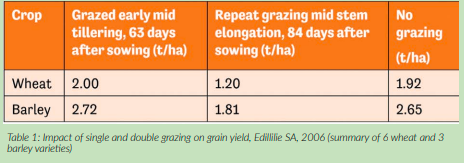
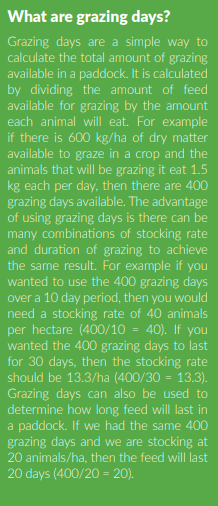
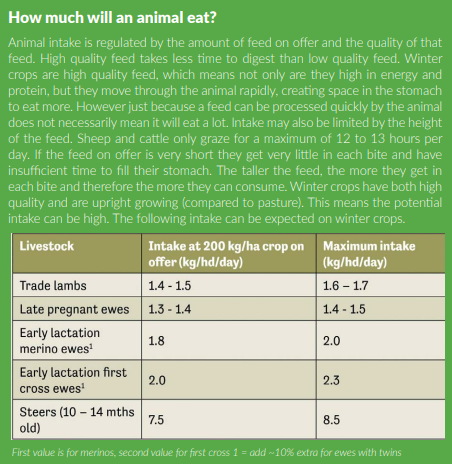
Grazing Cropped Land
There are other considerations that farmers need to appreciate when grazing winter crops. The information presented here seeks to quantify the magnitude of these risks under different situations. With this understanding, each farmer can make a decision on whether to accept the risk and graze the crop.
Stubble after grazing
In most cases grazing will reduce the amount of stubble left compared to no grazing. The average across all observations was 37%, although there is less effect the earlier the crop is grazed. The average reduction during early vegetative growth was 18%, 29% during tillering and 64% in early stem elongation. The smaller reduction when grazed early is probably because there is more time for the plants to recover before stem elongation commences (figure 2). The reduction in remaining stubble may be useful for farmers who have difficulty managing high stubble loads. However for those farmers who can bale and sell the straw, grazing will reduce stubble available. There is limited information on the effect on silage or hay production, although it would be reasonable to assume similar reductions to the dry matter available for baling when grazing occurs.
Weeds
Creating weed problems is a common concern expressed by farmers grazing winter crops. The fear is that grazing removes crop competition, encourages germination of weed seeds and increases tillering once the weeds are grazed. Weed populations are dynamic, which makes a simple answer to the question does grazing increase weeds impossible to answer. However information from 12 trials conducted throughout the Grain and Graze program is beginning to shed light on weed populations and to enable some general statements to be made.
Weed free paddocks are the safest to graze When weed populations are already very low, grazing does not increase these populations, except with the possibility of opportunistic weeds such as toadrush (Juncus bufonius) which has an extremely long seed dormancy and only germinates when soil becomes saturated and pugged. An example is presented for annual ryegrass populations monitored for 4 years in South West Victoria (figure 3).

Crop competition is important in controlling weeds
Early crop competition will reduce weeds. This can be achieved through:
• Variety selection, using early vigorous types like oats and barley compared with winter wheat
• Higher sowing rates and narrow row spacing
• Earlier sowing, although this may compromise the timing of pre sowing herbicides
• Adequate fertility and soil conditions
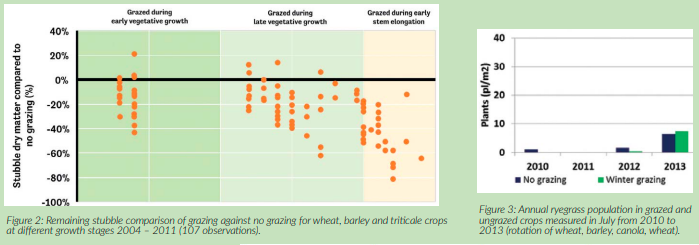
Grazing obviously removes plant competition and may change the subsequent weed populations. In a Tasmanian trial, the density of annual ryegrass plants was five to six times lower in ‘undergrazed’ plots with 10 lambs/ha compared with 20 lambs/ha or higher stocking rates of 30, 40 and 50 lambs/ ha (table 2). It was thought the extra leaf in the crop grazed with 10 lambs/ ha continued to shade the ryegrass, potentially reducing germination and vigour. In nil-grazed exclusion areas the density of ryegrass was comparable with the lowest stocking rate.

Grazing may increase or decrease weeds
The Grain and Graze data from 19 trials in Western Australia and Victoria (high rainfall) provides examples where weeds have increased, stayed the same or decreased after winter grazing (table 3).
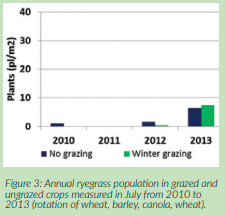
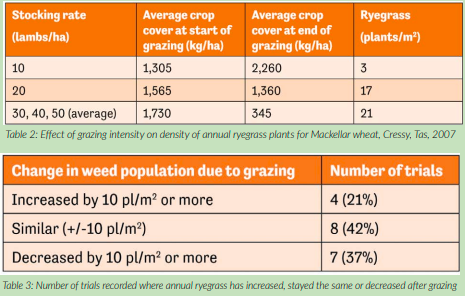
Intensity of grazing is important
If both weeds and cereals are intensively grazed to the same level early in the growth of the crop, the actively growing cereal re-grows more rapidly than most weeds, thereby putting the weeds at a disadvantage. Lax grazing, where only the top part of the canopy is removed has a tendency to reduce shading of the weeds by the cereal, allowing the weed to intercept more sunlight. While there are examples of sheep actively seeking out some weeds in a cereal crop, it is unlikely that this can be assumed over a range of crops, population of weeds, varieties and growth stages. Also the variability in the response of different weeds to grazing adds to the confusion. So what does this mean for grazing crops? The basic principles of weed control in winter grazed crops are the same as the practices used in ungrazed winter crops. Maximizing leaf production through high plant density, adequate soil fertility and selection for rapid growing crops all suit weed control strategies and DM production for grazing.
Soil structure
The impact of grazing on soil structure remains difficult to quantify. Trials in NSW and Victoria attempted to measure changes in soil structure after winter grazing which imposed extreme winter grazing conditions over multiple years. The main conclusions of this work were:
•Grazing resulted in visual changes to the soil surface (see picture) and reduced roughness in the soil surface (figure 4)

•There were no measurable changes to water infiltration or soil water storage as the result of grazing
•There was no difference in crop establishment in the year after grazing had occurred.
These findings are consistent with a review undertaken by the CSIRO that concluded grazing had no long term impact on soil structure and if there was any short term impact, the soil had an ability to ‘repair itself’, as long as the biological activity of the soil was adequate.
Animal health
Farmers who have been grazing winter crops in the last few years have observed some animal health issues. In interviews conducted with 14 farmers in South West Victoria who were grazing winter crops, 40% believed there were slightly higher ewe mortalities and 30% reported increased scouring and dags. Crops grazed in winter tend to be lush and are characterised by high moisture content and lower amounts fibre compared to more mature feed. This can potentially create animal health issues that need to be appreciated. Fibre Fibre is required in a diet to maintain healthy rumen function. It slows down the flow of feed through the animal (but can also restrict intake) and helps stimulate contractions or mixing of the feed in the stomach. Neutral detergent fibre (NDF) is the common test for digestible fibre in feeds.
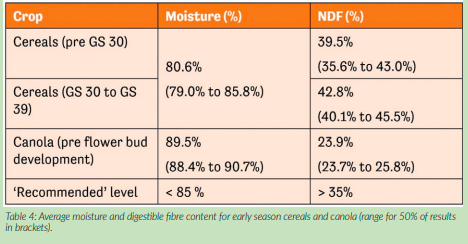
Currently there is no Australian standard for the amount of fibre to be fed to ruminants, however practical recommendations are that dairy cows require above 35% NDF to avoid reduction in milk fat.
Water Most water absorption in a ruminant occurs in the third stomach (the omasum) and the large intestine. The removal of water ‘hardens’ the excreted material. In diets with high moisture content, the animal is unable to absorb sufficient water to prevent loose faeces and appear to have ‘runny bums’. There is no benchmark for the maximum amount of water to prevent loose faeces although moisture contents above 85% are often observed to be threshold.
Winter crops in the early vegetative stage of growth are commonly low in fibre and high in moisture (table 4). Scouring may also be caused by a rapid change in diet, where the animal has not become accustomed to the different quality feed. The simplest way to minimise the potential scouring effect is to provide roughage just before entry to the crop and maintain access to this material during grazing. Late pregnant or lactating cows, or ewes, especially need good quality hay. Additional actions can include introducing stock to the type of feed over a three or four day period or only graze late in the afternoon for the first few days (to avoid potential nitrate poisoning). Always avoid turning hungry stock into a crop on an empty stomach.
Minerals
Work conducted by Hugh Dove, former Chief Research Scientist with CSIRO Plant Industry in Canberra identified that low magnesium was present in wheat crops. Acute magnesium deficiencies result in grass tetany, however more marginal deficiencies present themselves as lower than expected growth rates. The cause of the magnesium deficiency is an imbalance of potassium and sodium in the cereal the animals are grazing. Excess potassium combined with low sodium reduces the absorption of magnesium in the rumen. This deficiency can be easily rectified with a simple mineral lick. Sheep only need 20g/d and cattle 150 g/day.
Metabolic disorders
Canola can pose a greater risk to animal health than cereals, but this usually occurs when animals are suddenly introduced to the crop, often combined with conditions that make the crop stressed such as a lack of moisture, frost or herbicide application. The potential animal health problems include pneumonia, gastroenteritis, hypocalcemia, polio, liver damage, photosensitisation and nitrate poisoning. Stock should be fully vaccinated against enterotoxaemia before grazing. The recommendation when grazing canola is to offer hay and observe the animals closely for at least the first two weeks of grazing.
Crop diseases
The anecdotal information on diseases in cereal crops is quite variable. Some farmers believe grazing reduces disease such as rust by removing the diseased leaves and therefore the source of ongoing infection, or by reducing the canopy which improves air circulation and creates a less favourable condition for disease build up.
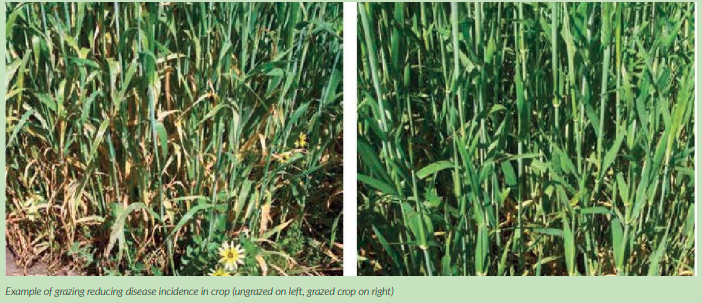
There is limited information on the effect of grazing on disease incidence. Observations of stripe and leaf rust in two barley and four wheat varieties in South West Victoria revealed no significant difference in rust incidence in the grazed and ungrazed plots, although the observations were taken during a drought year where the rust incidence was extremely low. In contrast a trial in Western Australia on barley where powdery mildew was about threshold control levels early in the season showed a substantial reduction in disease incidence until later in the season.